The Birth of Mineral Physics at the ANU in the 1970s
Abstract
:1. Introduction
2. Arrival and First Years at the ANU
3. Research of Graduate Students Ian Jackson and Leonie Jones
4. Related Research (1971–1976)
5. Interactions with Other Research Groups in the RSES
6. Post-1970 Research Collaboration between ANU and Stony Brook
Funding
Acknowledgments
Conflicts of Interest
References
- Liebermann, R.C. The role of serendipity in my career in mineral physics: 1968 to 2013. Phys. Earth Planet. Inter. 2014, 228, 307–323. [Google Scholar] [CrossRef]
- Anderson, O.L.; Liebermann, R.C. Equations for the pressure derivatives of the elastic constants for three cubic lattices, and some geophysical applications. Phys. Earth Planet. Inter. 1970, 3, 61–85. [Google Scholar] [CrossRef]
- Liebermann, R.C. Elastic properties of minerals determined from ultrasonic or compression data. Phys. Earth Planet. Inter. 1972, 5, 213–217. [Google Scholar] [CrossRef]
- Liebermann, R.C. Compressional velocities of polycrystalline olivine, spinel and rutile minerals. Earth Planet. Sci. Lett. 1972, 17, 263–268. [Google Scholar] [CrossRef]
- Liebermann, R.C. Elastic properties of germanate analogues of olivine, spinel and beta polymorphs of (Mg, Fe)2SiO4. Nat. Phys. Sci. 1973, 244, 105–107. [Google Scholar] [CrossRef]
- Liebermann, R.C. Elasticity of pyroxene-garnet and pyroxene-ilmenite phase transformations in germinates. Phys. Earth Planet. Inter. 1974, 8, 361–374. [Google Scholar] [CrossRef]
- Liebermann, R.C.; Mayson, D.J. Elastic properties of polycrystalline diopside (CaMgSi2O6). Phys. Earth Planet. Inter. 1976, 11, 1–4. [Google Scholar] [CrossRef]
- Liebermann, R.C. Elasticity of ilmenites. Phys. Earth Planet. Inter. 1976, 12, 5–10. [Google Scholar] [CrossRef]
- Liebermann, R.C.; Ringwood, A.E.; Major, A. Elasticity of stishovite. Earth Planet. Sci. Lett. 1976, 32, 129–140. [Google Scholar] [CrossRef]
- Liebermann, R.C.; Ringwood, A.E. Some comments on the elasticity of stishovite as determined by ultrasonic and static compression techniques. In High-Pressure Research: Applications in Geophysics; Manghnani, M.H., Akimoto, S., Eds.; Academic Press: New York, NY, USA, 1977; pp. 343–349. [Google Scholar]
- Jackson, I.; Liebermann, R.C.; Ringwood, A.E. The elastic properties of (MgxFe1-xO) solid solutions. J. Phys. Chem. Miner. 1978, 3, 11–31. [Google Scholar] [CrossRef]
- Liebermann, R.C. Elastic properties of polycrystalline SnO2 and GeO2: Comparison with stishovite and rutile data. Phys. Earth Planet. Inter. 1973, 7, 461–465. [Google Scholar] [CrossRef]
- Liebermann, R.C. Elasticity of olivine (a), beta (b) and spinel (g) polymorphs of germanates and silicates. Geophys. J. R. Astron. Soc. 1975, 42, 899–929. [Google Scholar] [CrossRef]
- Liebermann, R.C. Elasticity of the ilmenite-perovskite phase transformation in CdTiO3. Earth Planet. Sci. Lett. 1976, 29, 326–332. [Google Scholar] [CrossRef]
- Jackson, I.N.S.; Liebermann, R.C. Melting and elastic shear instability of alkali halides. J. Phys. Chem. Solids 1974, 35, 1115–1119. [Google Scholar] [CrossRef]
- Jackson, I.N.S.; Liebermann, R.C.; Ringwood, A.E. Disproportionation of spinels into mixed oxides: Significance of cation configuration and implications for the mantle. Earth Planet. Sci. Lett. 1974, 24, 203–208. [Google Scholar] [CrossRef]
- Jones, L.E.A.; Liebermann, R.C. Elastic and thermal properties of fluoride and oxide analogues with the rocksalt, fluorite, rutile, perovskite structures. Phys. Earth Planet. Inter. 1974, 9, 101–107. [Google Scholar] [CrossRef]
- Liebermann, R.C.; Jones, L.E.A.; Ringwood, A.E. Elasticity of aluminate, titanate, stannate and germanate compounds with the perovskite structure. Phys. Earth Planet. Inter. 1977, 14, 165–178. [Google Scholar] [CrossRef]
- Green, D.H.; Liebermann, R.C. Phase equilibria and elastic properties of pyrolite model for the oceanic upper mantle. Tectonophysics 1976, 32, 61–92. [Google Scholar] [CrossRef]
- Liebermann, R.C.; Ringwood, A.E. Birch’s law and polymorphic phase transformations. J. Geophys. Res. 1973, 78, 6926–6932. [Google Scholar] [CrossRef]
- Liebermann, R.C. On velocity density systematics, polymorphic phase transformations, and the transition zone of the earth’s mantle. Comments Earth Sci. Geophys. 1973, 3, 127–133. [Google Scholar]
- Liebermann, R.C. Elasticity of the olivine-spinel and olivine-beta phase transformations and the 400 km. discontinuity of the mantle. J. Geophys. Res. 1973, 78, 7015–7017. [Google Scholar] [CrossRef]
- Liebermann, R.C.; Ringwood, A.E.; Mayson, D.J.; Major, A. Hot-pressing of polycrystalline aggregates at very high pressures for ultrasonic measurements. In Proceedings of the 4th International Conference on High Pressure, Kyoto, Japan, 25–29 November 1974; pp. 495–502. [Google Scholar]
- Gwanmesia, G.D.; Li, B.; Liebermann, R.C. Hot pressing of polycrystals of high-pressure phases of mantle minerals in multi-anvil apparatus. Pure Appl. Geophys. 1993, 141, 467–484. [Google Scholar] [CrossRef]
- Liebermann, R.C.; Ringwood, A.E. Elastic properties of anorthite and the nature of the lunar crust. Earth Planet. Sci. Lett. 1976, 31, 69–74. [Google Scholar] [CrossRef]
- Weidner, D.J.; Bass, J.D.; Ringwood, A.E.; Sinclair, E. The single-crystal elastic moduli of stishovite. J. Geophys. Res. 1982, 87, 40–474. [Google Scholar] [CrossRef]
- Liebermann, R.C.; Jackson, I.; Ringwood, A.E. Elasticity and phase equilibria of spinel disproportionation reactions. Geophys. J. R. Astron. Soc. 1977, 50, 553–586. [Google Scholar] [CrossRef] [Green Version]
- Rigden, S.M.; Jackson, I.N.S.; Niesler, H.; Liebermann, R.C.; Ringwood, A.E. Pressure dependence of the elastic wave velocities for Mg2GeO4 spinel up to 3 GPa. Geophys. Res. Lett. 1988, 15, 605–608. [Google Scholar] [CrossRef]
- Gwanmesia, G.; Liebermann, R.C.; Guyot, F. Hot-pressing and characterization of polycrystals of ß-Mg2SiO4 for acoustic velocity measurements. Geophys. Res. Lett. 1990, 17, 1331–1334. [Google Scholar] [CrossRef]
- Gwanmesia, G.D.; Rigden, S.; Jackson, I.; Liebermann, R.C. Pressure dependence of elastic wave velocity for β-Mg2SiO4 and the composition of the Earth’s mantle. Science 1990, 250, 794–797. [Google Scholar] [CrossRef]
- Rigden, S.M.; Gwanmesia, G.D.; FitzGerald, J.D.; Jackson, I.; Liebermann, R.C. Spinel elasticity and seismic structure of the transition zone of the mantle. Nature 1991, 354, 143–145. [Google Scholar] [CrossRef]
- Rigden, S.M.; Gwanmesia, G.; Jackson, I.; Liebermann, R.C. Progress in high-pressure ultrasonic interferometry: The pressure dependence of elasticity of high-pressure Mg2SiO4 polymorphs and constraints on the composition of the transition zone of the Earth’s mantle. In High Pressure Research: Applications to Earth and Planetary Sciences; Syono, Y., Manghnani, M.H., Eds.; Terra Scientific Publishing Co.: Tokyo, Japan; American Geophysical Union: Washington, DC, USA, 1992; pp. 167–182. [Google Scholar]
- Rigden, S.M.; Gwanmesia, G.D.; Liebermann, R.C. Elastic wave velocities of a pyrope-majorite garnet to 3 GPa. Phys. Earth Planet. Inter. 1994, 84, 35–44. [Google Scholar] [CrossRef]
- Li, B.; Rigden, S.M.; Liebermann, R.C. Elasticity of stishovite at high pressure. Phys. Earth Planet. Inter. 1996, 96, 113–127. [Google Scholar] [CrossRef]
- Li, B.; Jackson, I.; Gasparik, T.; Liebermann, R.C. Elastic wave velocity measurement in multi-anvil apparatus to 10 GPa using ultrasonic interferometry. Phys. Earth Planet. Inter. 1996, 98, 79–91. [Google Scholar] [CrossRef]
- Kung, J.; Rigden, S.; Gwanmesia, G. Elasticity of ScAlO3 at high pressure. Phys. Earth Planet. Inter. 2000, 118, 65–75. [Google Scholar] [CrossRef]
- Kung, J.; Rigden, S.; Jackson, I. Silicate perovskite analogue ScAlO3: Temperature dependence of elastic moduli. Phys. Earth Planet. Inter. 2000, 120, 299–314. [Google Scholar] [CrossRef]
- Kung, J.; Jackson, I.; Liebermann, R.C. High-temperature elasticity of polycrystalline orthoenstatite (MgSiO3). Am. Mineral. 2011, 96, 577–585. [Google Scholar] [CrossRef]
- Antao, S.M.; Jackson, I.; Li, B.; Kung, J.; Chen, J.; Hassan, I.; Liebermann, R.C.; Parise, J.B. High-temperature elasticity of magnesioeferrite spinel. Phys. Chem. Miner. 2007, 34, 345–350. [Google Scholar] [CrossRef]
- Chen, T.; Liebermann, R.C.; Zou, Y.; Li, Y.; Qi, X.; Li, B. Tracking silica in Earth’s upper mantle using new sound velocity data for coesite to 5.8 GPa and 1073 K. Geophys. Res. Lett. 2017, 44, 7757–7765. [Google Scholar] [CrossRef]
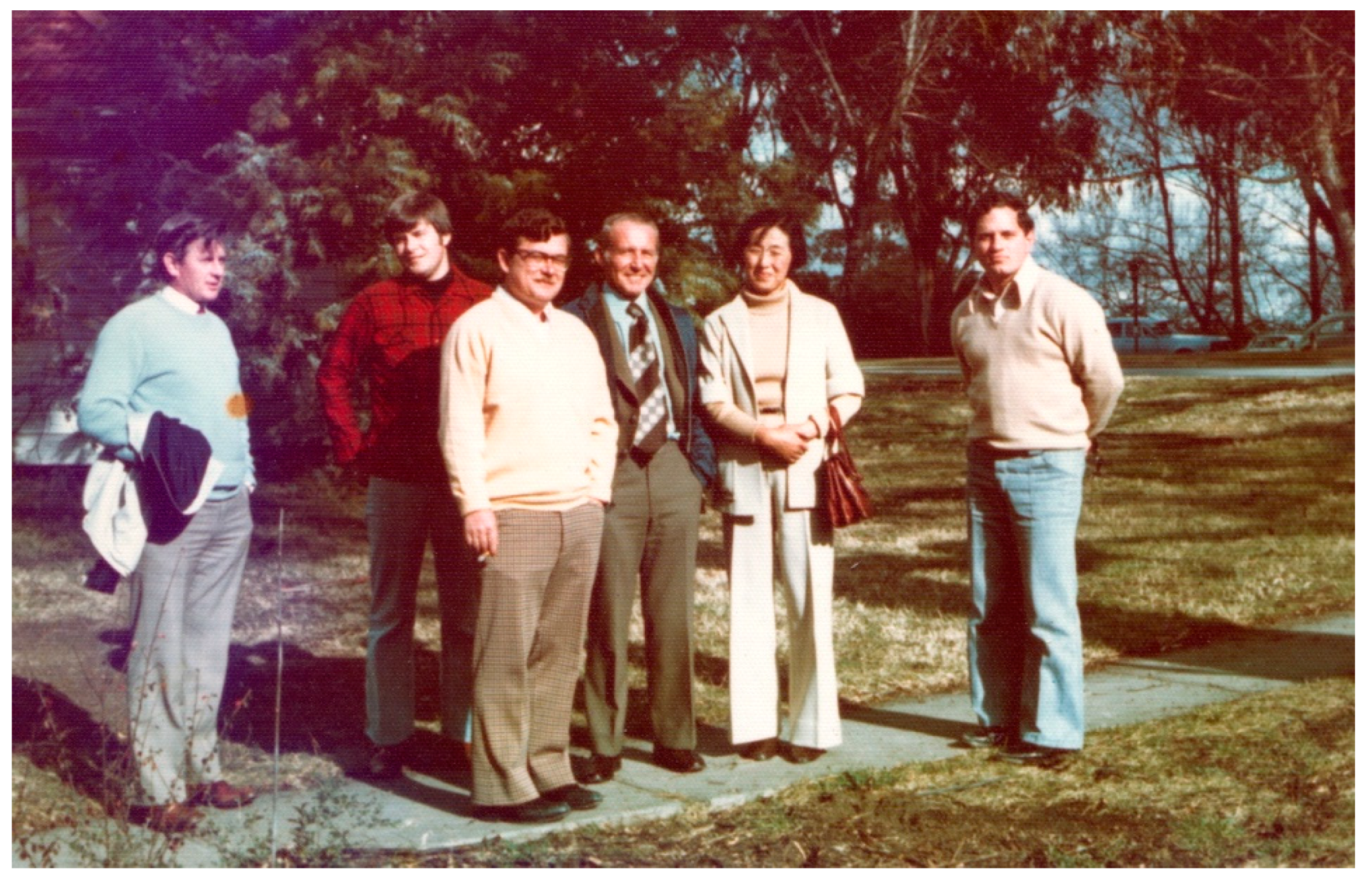
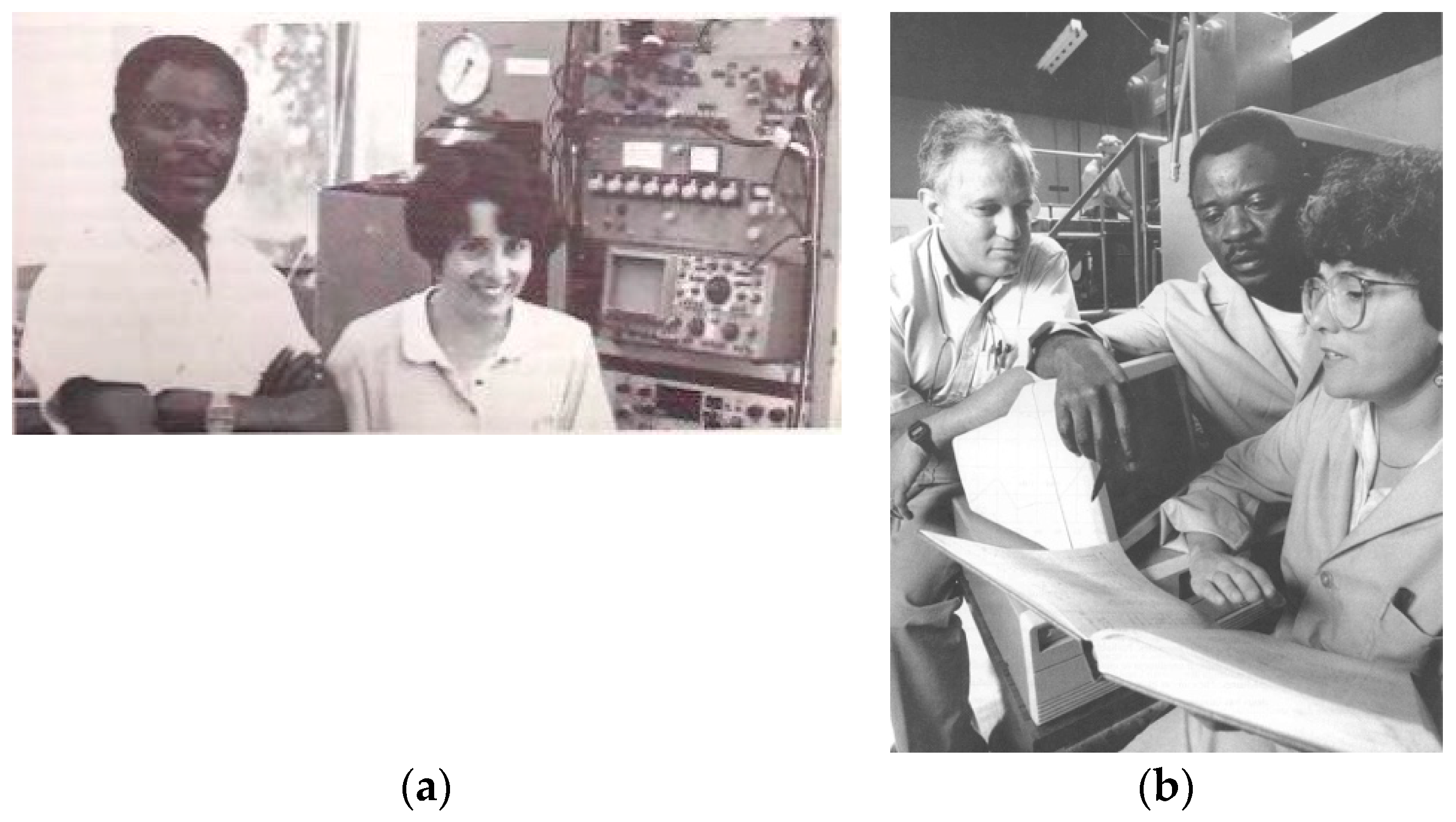
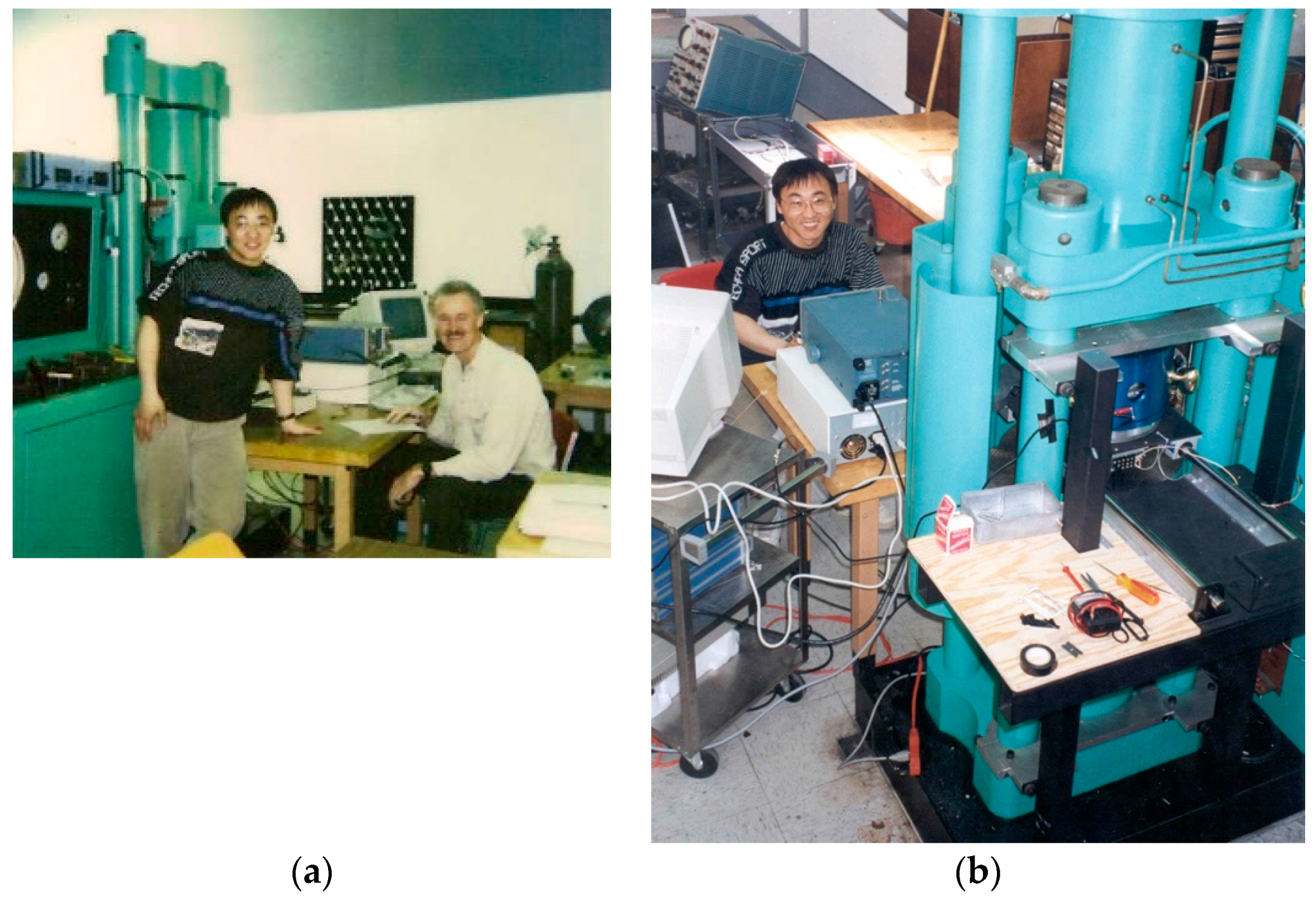
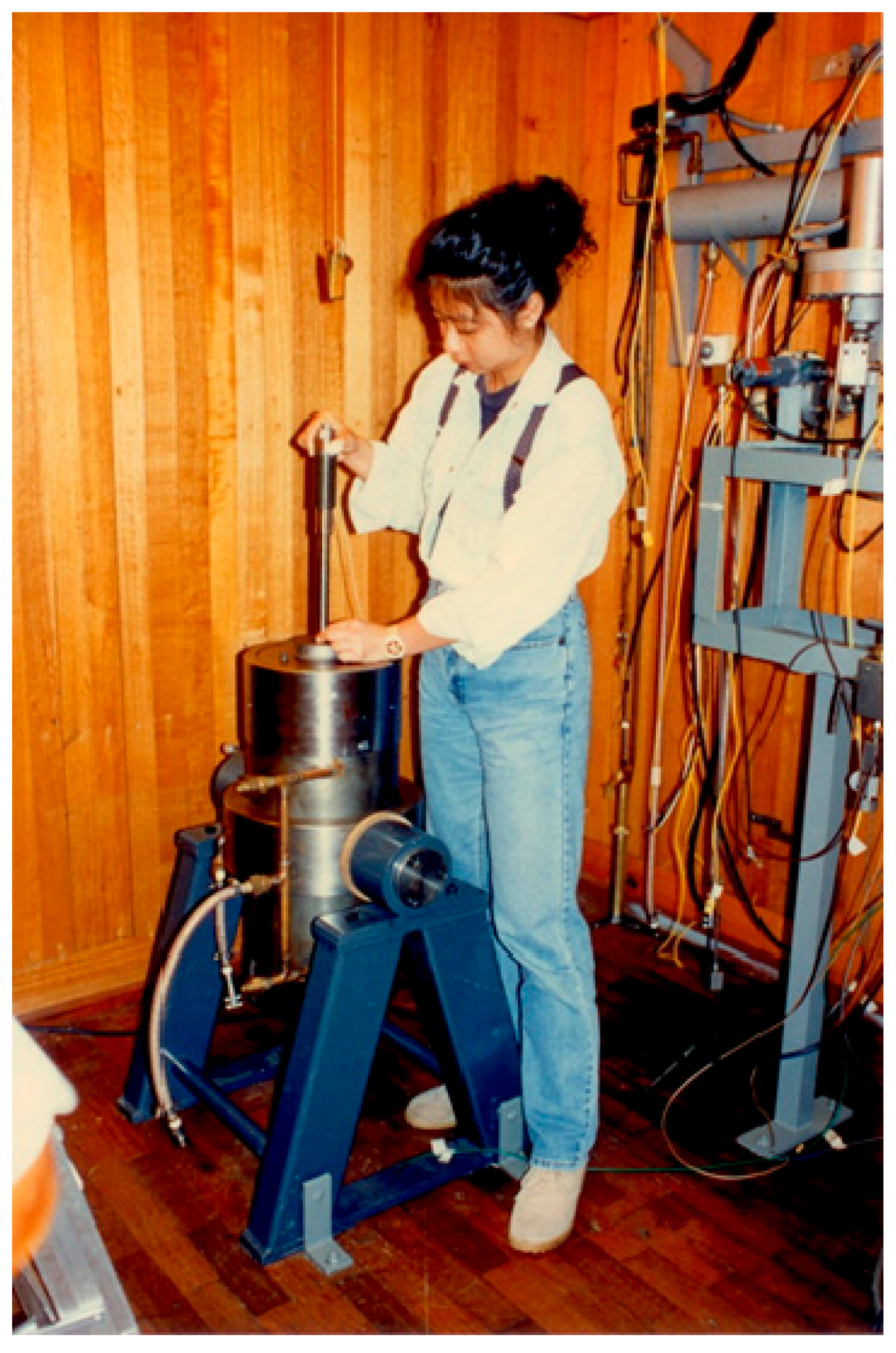
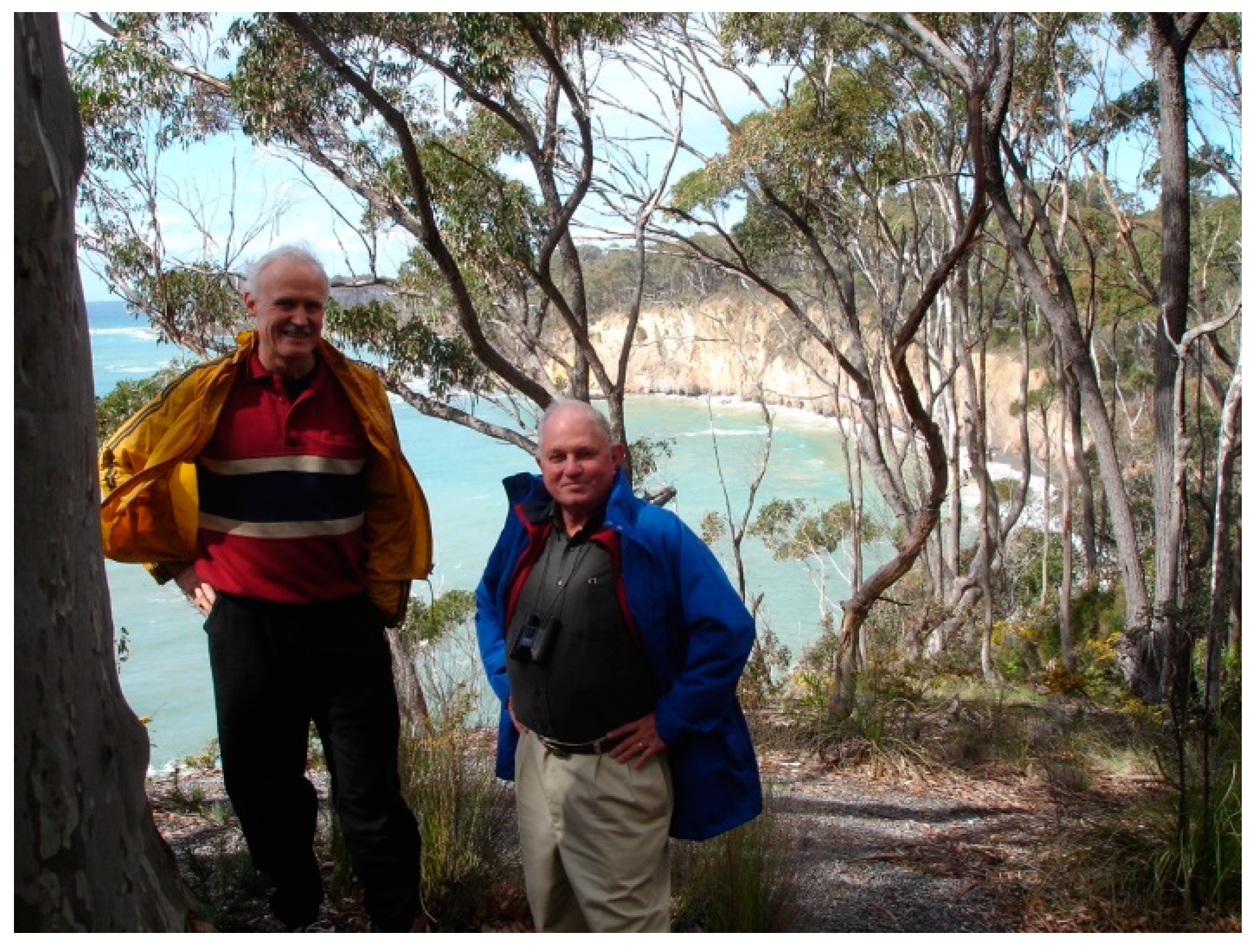
© 2020 by the author. Licensee MDPI, Basel, Switzerland. This article is an open access article distributed under the terms and conditions of the Creative Commons Attribution (CC BY) license (http://creativecommons.org/licenses/by/4.0/).
Share and Cite
Liebermann, R.C. The Birth of Mineral Physics at the ANU in the 1970s. Minerals 2020, 10, 163. https://doi.org/10.3390/min10020163
Liebermann RC. The Birth of Mineral Physics at the ANU in the 1970s. Minerals. 2020; 10(2):163. https://doi.org/10.3390/min10020163
Chicago/Turabian StyleLiebermann, Robert Cooper. 2020. "The Birth of Mineral Physics at the ANU in the 1970s" Minerals 10, no. 2: 163. https://doi.org/10.3390/min10020163




